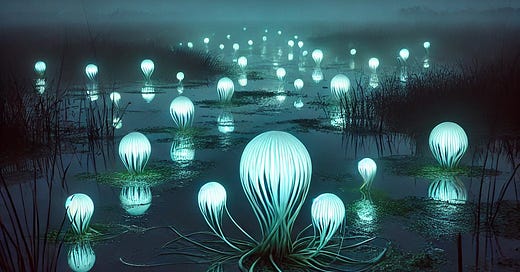Myth of the Day: Aleya
In West Bengal's marshes, ethereal lights beckon with tales of tragedies, entrapping or guiding the living.
Region/Culture: India, Asia
Mythos: Hindu Mythology (though it’s also more of a regional folklore, especially in West Bengal, rather than purely religious in context)
Primary Type/Nature: Undead/Cursed Beings
Mythical Attributes: Manifestations of unexplained marsh lights, often mistaken for ghostly apparitions.
Role in Mythos: Aleya lights are considered ominous signs that lead fishermen and villagers astray, making them lose their bearings.
Relation to Humans: Those who follow the Aleya lights often drown in marshes or lakes, as they’re led away from safe paths. Some believe these lights are the spirits of fishermen who died fishing, trying to signal to those still alive.
In the tranquil corners of West Bengal, as twilight casts long shadows over the waters, and the world below stills, a mysterious phenomenon haunts the marshlands. The locals, with a wary glint in their eyes, refer to these enigmas as “Aleya”. Often misconstrued as ghostly apparitions, the Aleyas are said to be more than mere marsh lights; they are the tales and echoes of tragedies long past.
Visually, Aleyas are ephemeral glowing orbs, appearing just over the water surfaces in marshy terrains. On nights, especially when the moon hides behind the curtain of clouds and the world is enveloped in darkness, these lights dance gracefully over the waters, like ethereal ballerinas lost in a haunting waltz. They seem almost alive, pulsating gently, their luminosity varying from the soft glow of fireflies to the brilliance of a torchlight. Their hues? Predominantly blue or green, but occasionally a soft white. They bob and weave, beckoning onlookers to follow them into the depths of the wetlands.
Legend holds that these lights aren’t merely natural phenomena, but rather are born out of the profound sorrows of the marshes. They are believed to be the spirits of fishermen, those unfortunate souls who met a watery demise, their lives cut short by the unpredictable temperament of the wetlands they depended upon. Instead of moving on, their souls are trapped, wandering the marshes and lakes, bound by the curse of the waters.
Now, in their afterlife as Aleyas, they reach out to the world of the living. Some say they are trying to guide others to safety, making up for their own tragic ends. Others argue that, like sirens of the western myths, they are calling out to lure the living into the very same trap that consumed them.
Within Hindu folklore and the regional narratives of West Bengal, the Aleya lights are heralded as ominous. Fishermen, in particular, are wary of them. While they might appear as inviting glimmers in the gloom, they have a dark side. These lights have been blamed for leading many astray. An unsuspecting fisherman, seeing an Aleya, might be tempted to follow, thinking it a path to safety or perhaps a fellow fisherman signaling. But alas, instead of guiding them to solid ground, the Aleyas often lead them deeper into the treacherous marshes, ensuring they lose their bearings.
Those who succumb, who follow these will-o’-the-wisps, often find themselves disoriented, and in the worst of cases, they drown, joining the mournful choir of souls trapped in the marshy abyss.
The power of the Aleyas lies in their allure. Their sheer ethereal beauty, their mysterious nature, and the tales that surround them make them almost irresistible to those unfamiliar with their legend. They harness the innate human curiosity, drawing the living closer with every bob and weave.
However, their enigmatic nature is also their weakness. Those who are familiar with their tales, who have been passed down the stories of the Aleyas from generation to generation, are less likely to be fooled by their mesmerizing dance. Knowledge, in this case, is the most potent weapon against their charm.
The Aleya, a fascinating blend of nature’s wonders and haunting tales of the past, is a testament to the rich tapestry of Indian folklore, especially that of West Bengal. It serves as a reminder that the line between the natural and the supernatural, the explained and the unexplained, is often blurred. And while science may one day demystify the Aleya lights, the stories, the emotions, and the traditions they evoke will always remain, whispered from one generation to the next, keeping alive the magic of the marshlands.
Suggested Further Reading
Hindu Myths: A Sourcebook Translated from the Sanskrit by Wendy Doniger
Myth = Mithya: Decoding Hindu Mythology by Devdutt Pattanaik
Explore more myths and wonders by visiting godsandmonsters.info.





